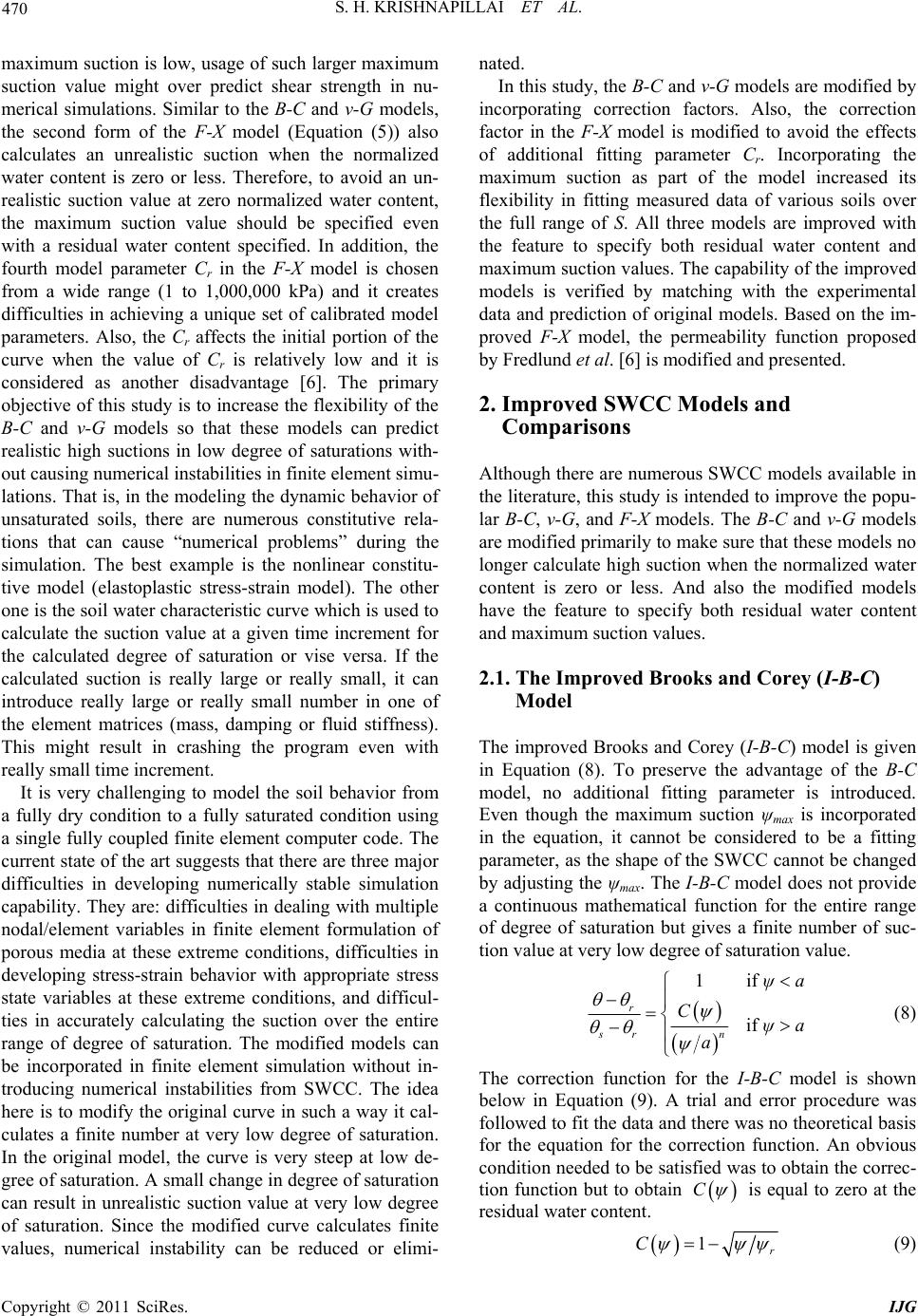
S. H. KRISHNAPILLAI ET AL.
470
ts that there are three major
di
itional fitting parameter Cr. Incorporating the
m
lthough there are nu merous SWCC models available in
e the popu-
lar models. The B-C and v-G models
e modified primarily to make sure that these models no
he improved Brooks and Corey (I-B-C) model is given
C
moditional fitting parameter is introduced.
ven though the maximum suction ψmax is incorporated
maximum suction is low, usage of such larger maximum
suction value might over predict shear strength in nu-
merical simulations. Similar to the B-C and v-G models,
the second form of the F-X model (Equation (5)) also
calculates an unrealistic suction when the normalized
water content is zero or less. Therefore, to avoid an un-
realistic suction value at zero normalized water content,
the maximum suction value should be specified even
with a residual water content specified. In addition, the
fourth model parameter Cr in the F-X model is chosen
from a wide range (1 to 1,000,000 kPa) and it creates
difficulties in achieving a unique set of calibrated model
parameters. Also, the Cr affects the initial portion of the
curve when the value of Cr is relatively low and it is
considered as another disadvantage [6]. The primary
objective of this study is to increase the flexibility o f the
B-C and v-G models so that these models can predict
realistic high suctions in low degree of saturations with-
out causing numerical instabilities in finite element simu-
lations. That is, in the modeling the dynamic behavior of
unsaturated soils, there are numerous constitutive rela-
tions that can cause “numerical problems” during the
simulation. The best example is the nonlinear constitu-
tive model (elastoplastic stress-strain model). The other
one is the soil water characteristic cu rve which is used to
calculate the suction value at a given time increment for
the calculated degree of saturation or vise versa. If the
calculated suction is really large or really small, it can
introduce really large or really small number in one of
the element matrices (mass, damping or fluid stiffness).
This might result in crashing the program even with
really small time increment.
It is very challenging to model the soil behavior from
a fully dry condition to a fully saturated condition using
a single fully coupled finite element computer code. The
current state of the art sugges
fficulties in developing numerically stable simulation
capability. They are: difficulties in dealing with multiple
nodal/element variables in finite element formulation of
porous media at these extreme conditions, difficulties in
developing stress-strain behavior with appropriate stress
state variables at these extreme conditions, and difficul-
ties in accurately calculating the suction over the entire
range of degree of saturation. The modified models can
be incorporated in finite element simulation without in-
troducing numerical instabilities from SWCC. The idea
here is to modify the original curve in such a way it cal-
culates a finite number at very low degree of saturation.
In the original model, the curve is very steep at low de-
gree of saturation. A small change in degree of saturation
can result in unrealistic suction value at very low degree
of saturation. Since the modified curve calculates finite
values, numerical instability can be reduced or elimi-
nated.
In this study, the B-C and v-G models are modified by
incorporating correction factors. Also, the correction
factor in the F-X model is modified to avoid the effects
of add
aximum suction as part of the model increased its
flexibility in fitting measured data of various soils over
the full range of S. All three models are improved with
the feature to specify both residual water content and
maximum suction values. The capability of the improved
models is verified by matching with the experimental
data and prediction of original models. Based on the im-
proved F-X model, the permeability function proposed
by Fredlund et al. [6] is modified and presented.
2. Improved SWCC Models and
Comparisons
A
the literature, this study is intended to improv
B-C, v-G, and F-X
ar
longer calculate high suction when the normalized water
content is zero or less. And also the modified models
have the feature to specify both residual water content
an d maximum suction values.
2.1. The Improved Brooks and Corey (I-B-C)
Model
T
in Equation (8). To preserve the advantage of the B-
el, no add
E
in the equation, it cannot be considered to be a fitting
parameter, as the shape of the SWCC cannot be changed
by adjusting the ψmax. The I-B-C model does not provide
a continuous mathematical function for the entire range
of degree of saturation but gives a finite number of suc-
tion value at very low degree of saturation value.
1if
if
r
n
sr
ψa
Cψa
a
(8)
The correction function for the I-B-C model is shown
below in Equation (9). A trial and error
followed to fit the data and there was no theoretical basis
for the equation for the correction function. An obvious
procedure was
condition needed to be satisfied was to obtain the correc-
tion function but to obtain
C
is equal to zero at the
residual water content.
1r
C
(9)
Copyright © 2011 SciRes. IJG